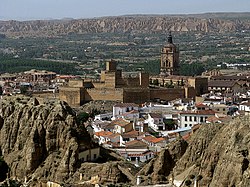Guadix
Guadix | ||
|---|---|---|
 | ||
| Coordinates: 37°18′2″N 3°8′6″W / 37.30056°N 3.13500°W | ||
| Country | ||
| Province | Postal code 18500 | |
| Website | Official website | |
Guadix (Spanish pronunciation:
The city lies at an altitude of 913 metres,[2] in the centre of the Hoya of Guadix, a high plain at the northern foothills of the Sierra Nevada. It is located on the Linares Baeza–Almería railway. The city was built in the vicinity of gullies and badlands.
History
Early history
Evidence of human settlement in the area surrounding Guadix goes back to at least the Bronze Age.
Ancient
Guadix el Viejo, 6 km northwest, was the Roman Acci (also Accitum) mentioned in
According to Macrobius, the primitive inhabitants paid homage to Mars under the name of Neton. Julius Caesar established the Roman colony called Julia Gemella. According to tradition, it was the seat of the first bishopric in Hispania, in the 2nd century.

Roman coins were minted at Julia Gemella, and the settlement continued to be an important centre of commerce, leaving artifacts such as the Pedestal of Isis, as well as the ruins of a Roman theatre. In addition, a network of sewers, galleries and water conduits have been uncovered in the city, as well as the possible remains of a Roman temple.
Acci would have enjoyed the benefits of the Ius Italicum, which would have favoured social and economic development.
The fall of the Western Roman Empire negatively influenced the status of Acci, whose population may have in large part moved to rural areas,[3] and the city is known to have been one of the first in the Iberian Peninsula to adopt Catholicism. Few remains have been found dating from the IV to the XI century.
From the Moors to the Reconquista
After 711 it rose to some importance as a Moorish fortress and trading station, renamed Wadi 'Ashi ("the
The civil wars in the kingdom of Granada turned Guadix into the capital of a short-lived kingdom ruled by
Modern
By the end of the 19th century, Guadix had been famous for its cutlery; but its newer manufactures (chiefly earthenware, hempen goods, and hats) did not contribute to the city's economy significantly. Trade of wool, cotton, flax, corn and liqueurs took place in the city. The warm mineral springs of Cortes y Graena, once commonly frequented during the summer, are located roughly 10 kilometres west of Guadix.[4]
The novelist
Landscape
The Hoya Basin has been subject to erosion due to the presence of small rivers in the surrounding elevations, which have given the area its characteristic landscape of gullies and badlands. The sediments of the rivers Fardes and Guadix have turned the region into a fertile, then irrigated area, where the use of the land ranges from the cultivation of fruit trees, where peach cultivation abounds, to forestry, in particular that of poplar groves, as well as the sowing of cereals, leguminous plants and vegetables.
Main sights


- Guadix Cathedral (16th-18th centuries), built over a Moorish mosque in Gothic-Renaissance style. The façade is in Baroque style.
- Church of St. Augustine (18th century),
- Church of Santiago (1540), with a Plateresque portal
- Convent and church of the Conception
- Alcazaba, a Moorish fortress commanding the town
- Barrio de Santiago, a neighborhood characterized by troglodyte houses carved in tuff rocks

Notable people
- Pedro de Mendoza
- Antonio Mira de Amescua
- Gaspar de Ávalos de la Cueva
- Pedro Antonio de Alarcón
- Ibn Tufayl
International relations
- Twin towns — Sister cities
Guadix is
Guadix has also reached a "green-twinning" agreement with Piaseczno, Poland.[10]
See also
References
- ^ Municipal Register of Spain 2018. National Statistics Institute.
- AEMET. Archivedfrom the original on 8 July 2020. Retrieved 9 July 2020.
- ^ "Breve historia de la ciudad de Guadix | Patrimonio de Guadix". patrimonioguadix.es. Archived from the original on 2 January 2023. Retrieved 2 January 2023.
- ^ a b c One or more of the preceding sentences incorporates text from a publication now in the public domain: Chisholm, Hugh, ed. (1911). "Guadix". Encyclopædia Britannica. Vol. 12 (11th ed.). Cambridge University Press. p. 646.
- ^ Stillwell, Richard (1976). "Acci (Guadix), Granada, Spain". Princeton Encyclopedia of Classical Sites. Archived from the original on 3 May 2008. Retrieved 4 April 2019.
- ^ Mérimée, Prosper (1848). "Histoire de Dan Pédre". Revue des deux mondes (in French). Au bureau de la Revue des deux mondes. pp. 280–281. Retrieved 15 July 2013.
- Fundación Biblioteca Virtual Miguel de Cervantes (in Spanish). Archivedfrom the original on 4 April 2019. Retrieved 4 April 2019.
- ^ "Celanova colabora con Guadix para instalar un monumento a San Torcuato". Ideal. 22 February 2019. Archived from the original on 23 February 2019. Retrieved 9 July 2020.
- ^ "L'Arboç se hermana con Guadix". Diari de Tarragona. 30 September 2019. Archived from the original on 11 July 2020. Retrieved 9 July 2020.
- ^ "Acuerdos de hermanamiento o twinning" (PDF). green-twinning.eu. 2012. Archived (PDF) from the original on 2021-07-31. Retrieved 2020-07-09.
 This article incorporates text from a publication now in the public domain: Herbermann, Charles, ed. (1913). "Diocese of Guadix". Catholic Encyclopedia. New York: Robert Appleton Company.
This article incorporates text from a publication now in the public domain: Herbermann, Charles, ed. (1913). "Diocese of Guadix". Catholic Encyclopedia. New York: Robert Appleton Company.




